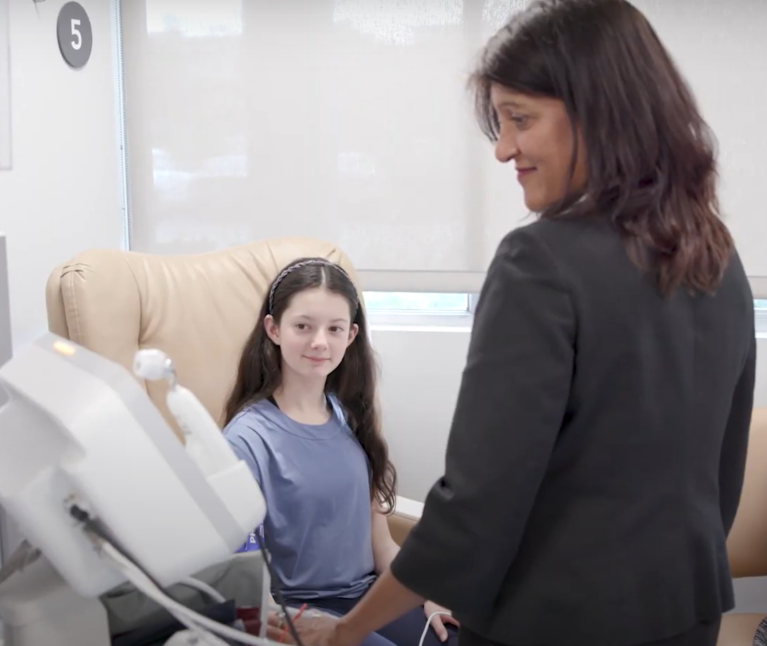Life’s biggest celebrations center on food—from birthday parties to holidays—but for children with severe allergies, those milestones can be fraught. The fear of accidental exposure to allergens creates a constant state of vigilance, requiring careful food preparation, avoiding potential triggers, and carrying emergency medication like epinephrine auto-injectors (EpiPens).
In 2014, Sean Parker decided it was time to move beyond reactive food allergy care to finding cures and donated a transformative $24 million to the Stanford School of Medicine. “There was a critical need for funding the basic science in immunology and allergy research,” Parker says. “Stanford is a global leader in the type of interdisciplinary collaboration required to bring the breakthroughs we’ve been seeing in immunology to allergy research.” This month marks the 10th anniversary of the Sean N. Parker Center for Allergy and Asthma Research at Stanford University.
Food, drug, environmental, and other allergies can have life-altering consequences for millions of people worldwide. The rate of food allergy diagnoses has steadily climbed in recent decades, with nearly 8% of children and 10% of adults in the U.S. now living with these allergic responses. For children with asthma, the statistics are even more alarming: In California, 60% of these children also suffer from allergies.
For 10 years, the Parker Center has worked to transform the lives of patients and families through innovative science and compassionate care. Now led by co-Directors Sharon Chinthrajah, MD, and Scott Boyd, MD, PhD, the Parker Center has united specialists in a range of fields, including internal medicine, pathology, immunology, bioengineering, and genetics around two shared goals: unraveling the fundamental immunology driving asthma and allergic disease and discovering new approaches to prevent, diagnose, and treat allergies. In just a decade, the Parker Center has become a hub for groundbreaking research studies and innovative, multidisciplinary collaborations with institutions across the globe.
Today, the Parker Center is 90% supported by philanthropy, with more than 3,000 donors standing together to support its urgent work.
A Commitment to Research Excellence
The first institution of its kind worldwide, the Parker Center’s mission is to bring relief to those living with the daily struggles of food allergies and asthma—sickness, fear, pain, isolation, and, for some, life-threatening reactions.
“Over the past 10 years, we’ve experienced enormous growth—in pioneering basic science research, groundbreaking clinical trials, and inspiring publications, and competitive funding from the National Institutes of Health,” says Thomas Montine, MD, PhD, chair of the Department of Pathology that houses the Parker Center. Powered by philanthropy, this growth has enabled life-changing benefits for our patients.
In February 2024, the Parker Center celebrated a milestone achievement with the FDA-approval of omalizumab (Xolair), the first-ever drug to protect broadly from multiple food reactions. This discovery resulted from Stanford-led clinical trials and finally, a large clinical trial co-chaired by Dr. Chinthrajah—the OUtMATCH study (Omalizumab as Monotherapy and as Adjunct Therapy to Multi-Allergen OIT in Food Allergic Participants), which tested Xolair as a solo treatment for food allergies. Xolair is the first genuine alternative to current treatments, which involve oral immunotherapy and emergency interventions—all of which can have dangerous side effects and create significant psychosocial burdens.
In addition to this pivotal work on Xolair, the Parker Center has led or participated in more than 80 clinical trials since its launch, including those that led to FDA approval of Palforzia, an oral immunotherapy medication for peanut allergy, and that demonstrated skin patches desensitized toddlers to peanuts.
Translating Advancements to Our Patients and Communities
“Providing hope and promise to patients with allergies is the driving force behind everything we do,” says Dr. Chinthrajah. “Food allergies are a family affair and our team provides these families with the tools to live their lives to the fullest.” The Parker Center’s physician-scientists are currently investigating how to combine omalizumab with other interventions, including treating the skin and gut microbiomes and unearthing the genetic risks behind allergies. This precision-medicine approach ensures each child gets the right care for their unique needs.
Translating scientific research from the lab bench to the bedside is one of the Parker Center’s greatest strengths—powered by Stanford’s culture of innovation and collaboration. Dr. Boyd explains that “the synergy between discovery science and clinical innovation means our teams can move quickly from fundamental discoveries to translational research and clinical trials—and, ideally, new protocols for better care.”
The Parker Center has also led community initiatives to improve patient and family quality of life and advance health equity. This includes tackling food insecurity and food allergy management, developing an early stress detection and treatment tool to remove barriers to care, and even helping address the COVID-19 pandemic by mobilizing its resources to collect bio samples from patients, analyze immune responses to the virus, and launch clinical trials—data used to garner emergency approval from the FDA for remdesivir. An additional gift from the Parker Foundation was also instrumental in advancing COVID-19 vaccine research, demonstrating minimal allergy risk and elucidating mechanisms behind long-term immunity.
The opening of the David and Julia Koch Clinic in October 2022, powered by another visionary philanthropic gift, further increased the Parker Center’s capacity for clinical research and world-class care. With the Koch Clinic, we’ve tripled our number of patient visit rooms in a bright and welcoming space—allowing us to see more patients, conduct more clinical trials, and bring hope to many more families.
The Vision for The Next 10 Years
The future of allergy and asthma research holds immense promise. “Changing how allergic disease is understood, diagnosed, treated, and prevented is within our grasp,” says Dr. Montine. “I am excited for the next decade of innovative discovery and profoundly impactful patient care.”
Looking forward, scientists at the Parker Center will leverage innovative tools, like artificial intelligence and CRISPR technology, to discover the root cause of asthma and allergic disease on molecular and genomic levels. There is still much to learn about the disease pathways involved in asthma—created by a complex web of genetic and environmental factors, including wildfires and pollution. Our team plans to apply machine learning to explore the metabolomic profiles of our patients with asthma, pinpointing personalized treatments.
With dedicated basic scientists—studying allergies and asthma from diverse lenses like immunology, pulmonology, genetics, and computational biology—we are poised to make strides that previously seemed like science fiction. “The team has taken powerful steps toward understanding our complex immune mechanisms,” says Parker, “and I look forward to the day when immunotherapy for allergies is the standard of care.”
The ultimate goal? We envision a future in which asthma and allergies no longer burden kids and families, a time when physician-scientists can reprogram the immune system to protect itself.
If you’re interested in supporting the Sean N. Parker Center for Allergy & Asthma Research, please email Melanie Ranen.



